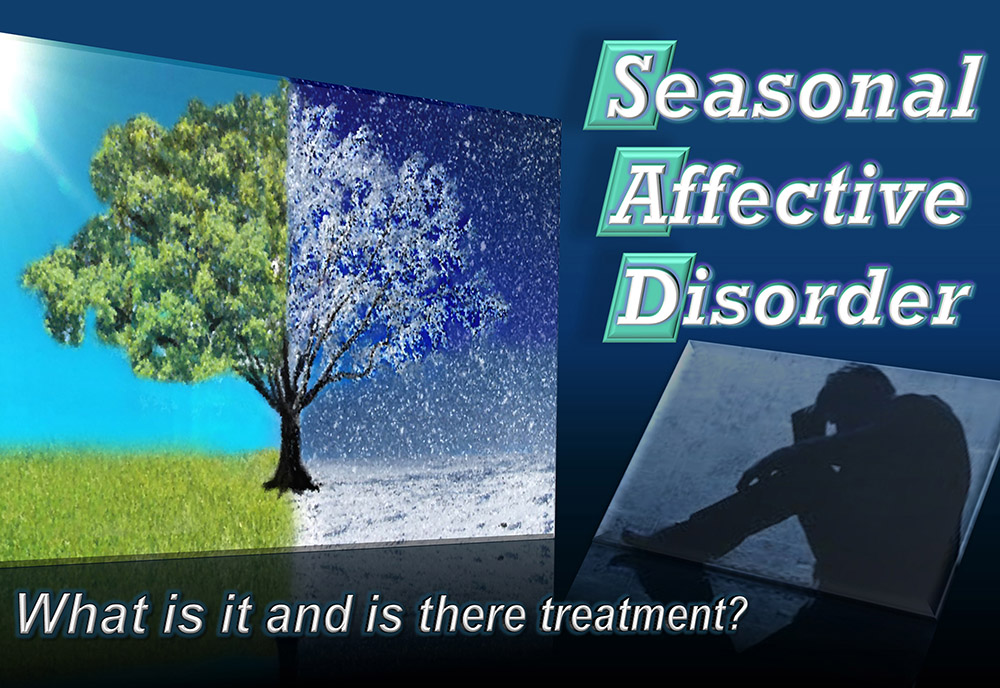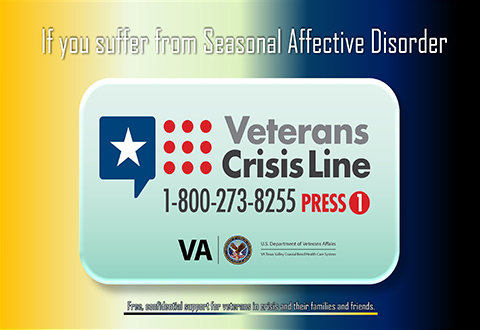Veterans Health Administration
Help for Veterans with Seasonal Affective Disorder

Help for Veterans with Seasonal Affective Disorder
What is seasonal affective Disorder (SAD)?
Seasonal Affective Disorder is a condition associated with feeling sad or blue during certain times of the year. It is a disorder that triggers symptoms of depression, most commonly in the fall or winter. In the fall and winter there is less sunlight, hence it is sometimes called winter depression.
Psychiatrists and other mental health clinicians diagnose depression by documenting low or sad mood, irritability, feeling of guilt or shame, problems with sleep, poor concentration or attention (memory problems), low energy or motivation, poor appetite and thoughts off self-harm.
SAD can mimic other medical conditions, such as anemia, hypothyroidism, diabetes, infections. Hence a medical work up may be needed--including levels of some vitamins, like vitamin D.
Get more sun, stay active, and get to a brighter place.
You may have SAD if in the last 2 years, you feel depressed in this season and normal during rest of the year. You may also have SAD if your depression for which you are being treated gets worse in this season.
Your symptoms will get better on their own when a new season arrives, often in spring or summer. But treatment can make you feel better sooner.

Is there treatment?
Light therapy, also called phototherapy, generally works well for SAD. You need to sit in front of a box or lamp that gives out up to 10,000 lux of fluorescent light—more than 20 times brighter than most indoor light. Researchers think that light helps your brain make more serotonin, a neurotransmitter that affects your mood. You’ll sit 12-18 inches in front of the light for 30 minutes or more a day, 3 times per week at least. The light must shine on your back or chest. You can read a book to pass the time. Do not stare at the light. You will feel better after 1- 2 weeks.
You may also want to see a medical provider to consider taking medications to increase serotonin levels. Your doctor may also recommend talk therapy such as cognitive behavioral therapy. You will learn behavioral skills to do pleasurable things during the winter, notice and change negative thoughts or manage stress.
In conclusion, it is important to consider all type of treatment. Get more sun, stay active, get to a brighter place and work toward sleeping the right amount of time.
Consider talking to a professional to identify ways of coping with SAD. EAP counselors are available to guide you during this time. Do not feel frightened to talk about your problems. They are there to help you.
For more information about Seasonal Affective Disorder visit the National Institute of Mental Health by clicking on the link below:
https://www.nimh.nih.gov/health/topics/seasonal-affective-disorder/index.shtm
Dr. Esteban A. Gonzalez is a board-certified psychiatrist with more than 30 years of experience, and is a fellow of the American Psychiatric Association. He works as the Behavioral Health Integration Program (BHIP) psychiatrist at the VA’s McAllen Outpatient Clinic, part of the Texas Valley Coastal Bend Health Care System.



















